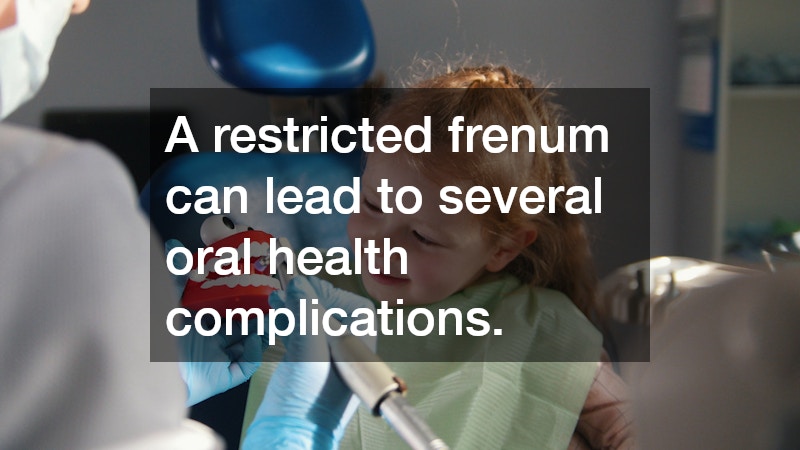A frenectomy is a minor surgical procedure designed to remove or modify the frenum, a small fold of tissue that connects the lips, cheeks, or tongue to the jaw and gums. While small, this tissue can sometimes restrict movement or cause oral complications, leading to difficulties with speech, eating, or oral hygiene. Frenectomies are relatively common in both dental and medical care and can greatly improve oral function and comfort.
Understanding what a frenectomy involves and when it is recommended helps patients make informed decisions about their oral health.
What Happens During a Frenectomy Procedure?
Preparation for the Procedure
Before performing a frenectomy, a thorough consultation is conducted by a dentist, oral surgeon, or other qualified healthcare professional. During this evaluation, the provider examines the mouth to determine the location and severity of the frenum restriction. They may take photos or scans to plan the procedure accurately. The decision to proceed is based on symptoms such as speech difficulties, gum recession, feeding problems in infants, or orthodontic concerns. The provider will also review medical history, explain the procedure, and discuss anesthesia options for comfort.
The Surgical Process
A frenectomy can be performed using either traditional surgical instruments or modern laser technology. In a traditional frenectomy, a small incision is made to remove or reshape the frenum, followed by the placement of a few dissolvable stitches. Laser frenectomy, on the other hand, uses concentrated light energy to precisely remove tissue while minimizing bleeding and reducing discomfort. The laser method is often preferred for its precision, faster healing, and minimal need for sutures. The procedure itself is typically quick, lasting only a few minutes, and is performed under local anesthesia for older children and adults, or with gentle sedation when necessary.
Recovery and Aftercare
Recovery from a frenectomy is usually straightforward and relatively short. Patients may experience mild soreness or swelling for a day or two, which can be managed with over-the-counter pain relief and saltwater rinses. It is important to keep the area clean and follow any stretching or movement exercises recommended by the provider to prevent the tissue from reattaching. Most patients heal completely within one to two weeks. Those who undergo laser frenectomies often experience faster healing times and less post-procedure discomfort.
Why Is a Frenectomy Needed?
Common Medical Reasons
A frenectomy is often performed to correct conditions such as tongue-tie (ankyloglossia) and lip-tie, which occur when the frenum is too short or tight, restricting natural movement. In infants, these conditions can interfere with breastfeeding, while in older children and adults, they can cause speech difficulties or contribute to dental problems. In some cases, a frenectomy is also performed to help with denture fitting or to address gum tension that contributes to recession.
Impact on Oral Health
A restricted frenum can lead to several oral health complications. For example, a tight upper lip frenum may cause spacing between the front teeth or make it difficult to brush and floss effectively, increasing the risk of plaque buildup and gum inflammation. A tongue-tie can limit mobility, affecting speech clarity, swallowing, and oral hygiene. Addressing these restrictions through a frenectomy can restore proper movement, allowing for better oral function and hygiene.
Benefits of Undergoing the Procedure
The benefits of a frenectomy often extend beyond physical comfort. For infants, it can improve feeding efficiency and reduce discomfort for both the baby and the mother. For older patients, the procedure can enhance speech clarity, improve dental alignment, and prevent gum issues associated with tension or limited movement. Many patients also experience increased confidence and overall quality of life after treatment.
Who Should Consider a Frenectomy?
Infants and Young Children
Frenectomies are frequently recommended for infants who experience difficulty latching or feeding due to tongue-tie or lip-tie. Early intervention can support proper feeding, promote weight gain, and prevent developmental speech problems. Pediatric dentists and lactation consultants often work together to identify these issues and determine the best time for treatment.
Adults with Lingual or Labial Impediments
Adults may also benefit from a frenectomy if a restricted frenum affects speech, causes tension on the gums, or interferes with orthodontic treatment. In some cases, a frenectomy can be performed in conjunction with other dental procedures to improve outcomes, such as during orthodontic alignment or periodontal therapy.
Consultation with Healthcare Providers
It is important to consult with a qualified dentist, periodontist, or oral surgeon before undergoing a frenectomy. A thorough evaluation ensures that the treatment is necessary and that it addresses the specific issue affecting the patient. The healthcare provider can also explain the expected results, outline potential risks, and recommend post-procedure care for optimal recovery.
A restricted frenum may seem like a small issue, but it can have a significant impact on oral health, speech, and overall comfort. A frenectomy is a safe, effective solution for patients of all ages who experience these challenges. Understanding the purpose of the procedure, when it is recommended, and what recovery entails can help individuals make confident decisions about their care. If you suspect that a frenum restriction is affecting you or your child, consult a dental or medical professional to determine whether a frenectomy can improve function and quality of life.






